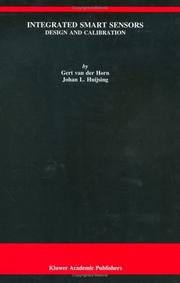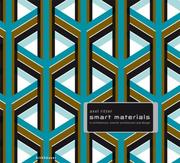| Listing 1 - 3 of 3 |
Sort by
|

ISBN: 0792380045 1441950168 1475728905 9780792380047 Year: 1998 Volume: SECS 419 Publisher: Boston Kluwer
Abstract | Keywords | Export | Availability | Bookmark
 Loading...
Loading...Choose an application
- Reference Manager
- EndNote
- RefWorks (Direct export to RefWorks)
1 1. 1 Introduction The (signal processing and storage) capacity ofthe human brain enables us to become powerful autonomous beings, but only if our brains operate in conjunction with (at least some of) our senses and muscles. Using these organs, we can interact with our environment, learn to adapt, and improve important aspects of our life. Similarly, the signal processing capabilities of modern electronics (computers) could be combined with electronic sensors and actuators to enable interaction with, and adaptation to, the (non-electrical) environment. This willlead to smarter and more powerful automated tools and machines. To facilitate and stimulate such a development, easy-to-use low-cost sensors are needed. The combination of electronic interface functions and a sensor in an integrated smart sensor, that provides a standard, digital, and bus-compatible output, would simplify the connection of sensors to standard electronic signal processors (microcontrollers, computers, etc. ). Currently, the calibration procedure, required for standardization of the sensor output signal level, contributes largely to the production costs of accurate sensors. To enable automation of the calibration procedure, and hence reduce the sensor fabrication costs, a digital calibrationjunction should be included in the smart sensor. INTEGRATED SMART SENSORS: Design and Calibration Introduction 1. 2 Sensors and actuators In industry many processes are electronically controlled. As depicted in Fig.
Detectors --- Smart materials --- Calibration --- 681.586 --- Transducers. Sensors --- 681.586 Transducers. Sensors --- Adaptive materials --- Intelligent materials --- Sense-able materials --- Materials --- Electrical engineering. --- Signal processing. --- Image processing. --- Speech processing systems. --- Electrical Engineering. --- Signal, Image and Speech Processing. --- Computational linguistics --- Electronic systems --- Information theory --- Modulation theory --- Oral communication --- Speech --- Telecommunication --- Singing voice synthesizers --- Pictorial data processing --- Picture processing --- Processing, Image --- Imaging systems --- Optical data processing --- Processing, Signal --- Information measurement --- Signal theory (Telecommunication) --- Electric engineering --- Engineering --- Detectors - Calibration

ISBN: 376437327X 9783764373276 3764382279 9783764382278 1299864376 9781299864375 3764373261 9783764373269 Year: 2007 Publisher: Basel ; Boston : Birkhäuser,
Abstract | Keywords | Export | Availability | Bookmark
 Loading...
Loading...Choose an application
- Reference Manager
- EndNote
- RefWorks (Direct export to RefWorks)
Die Anwendung von Smart Materials in der Architektur ist ein innovatives, dynamisches Gebiet, in dem Forschung, Entwicklung und Anwendung im Bau fließend ineinander übergehen. Smart Materials mit ihren reversiblen Wechseleigenschaften reagieren auf Stimuli wie Licht, Temperatur und elektrisches Feld. Sie verändern sich dabei in Form, Farbe, Viskosität etc. Zu den faszinierendsten Entwicklungen gehören Formgedächtnis-Legierungen oder Phase Change Materials. Es lassen sich beispielsweise selbsttätig agierende kinetische Fassaden entwickeln oder auch Tapeten, die temperatur- und lichtabhängig Farbe und Muster verändern. Das Buch stellt einleitend die Entwicklung dieser Materialien sowie ihren Kontext in Architektur, Design und Kunst dar. Ein systematisch aufgebauter Überblick mit zahlreichen Details über Eigenschaften, Technologien, Produkte und Projekte wird anhand von rund zwanzig Materialgruppen gegeben. The use of smart materials in architecture is a dynamic and innovative area merging research, development, and use. Smart materials, with their reversible characteristics, respond to stimuli such as light, temperature, and electrical field by changing their form, color, viscosity, etc. One of the most fascinating developments is the advent of Phase Change Materials. These materials make it possible, for example, to develop self-acting, kinetic facades and wallpaper that changes its color and pattern based on temperature and light. The book presents the development of these materials and also describes their use in the contexts of architecture, design, and art. It offers a systematic overview with a detailed discussion of properties, technologies, products, and projects based on twenty groups of smart materials.
691 --- 691.8 --- 691.9 --- 691(035) --- 749.02 --- Architectuur industrieel design 21ste eeuw nieuwe materialen --- Smart materials --- 745.02 --- Axel Ritter --- architectuur --- bouwmaterialen --- design --- interieurvormgeving --- kunststoffen --- materiaalkunde --- materialen --- meubelkunst --- polymeren --- slimme materialen --- 688 --- 772.9 --- composieten --- glas --- metaal --- plastiek --- productdesign --- thermoharders --- thermoplasten --- titanium --- zonne --- zonneënergie --- Bouwmaterialen (architectuur) --- Kunststof --- Synthetische materialen --- Smart materials (design) --- Bouwmaterialen handboeken --- Meubelkunst en design technieken, materialen --- productdesign, afzonderlijke voorwerpen --- materials [matter] --- Innovation technologique --- Materiau intelligent --- Building materials. Building technology --- Architectuur ; industrieel design ; 21ste eeuw ; nieuwe materialen --- Bouwmaterialen ; handboeken --- Meubelkunst en design ; technieken, materialen --- Smart materials. --- Building materials. --- Architectural materials --- Architecture --- Building --- Building supplies --- Buildings --- Construction materials --- Structural materials --- Materials --- Adaptive materials --- Intelligent materials --- Sense-able materials --- Building materials --- Architecture intérieure --- Design --- Bouwmaterialen ; smart materials --- materials [substances]
Book
ISBN: 9781137374844 1137374845 1137374853 1349677086 Year: 2016 Publisher: London : Palgrave Macmillan UK : Imprint: Palgrave Pivot,
Abstract | Keywords | Export | Availability | Bookmark
 Loading...
Loading...Choose an application
- Reference Manager
- EndNote
- RefWorks (Direct export to RefWorks)
What can queer feminist writing strategies such as parody and irony do to outsmart the sexism of smart objects, environments and materials and open out the new dialecticism of structure and scale, critique and creativity? Drawing on science and technology studies and feminist theory, this book examines the gendering of current and future media technologies such as smart phones, Google glass, robot nurses, tablets and face recognition. Kember argues that there is a tendency to affirm and celebrate the existence of smart and often sexist objects, environments and materials in themselves; to elide writing and other forms of mediation; and to engage in disembodied knowledge practices. Disembodied knowledge practices tend towards a scientism that currently includes physics envy and are also masculinist. Where there is some degree of convergence between masculinist and feminist thinking about objects, environments and materials, there is also divergence, conflict and the possible opening towards a politics of imedia. Presenting a lively manifesto for refiguring imedia, this book forms an often neglected gender critique of developments in smart technologies and will be essential reading for scholars in Communication Studies, Cultural and Media, Science and Technology and Feminism.
Technology --- Technology and women --- Smart materials --- Social aspects --- Sex differences --- Technology and women. --- Smart materials. --- Adaptive materials --- Intelligent materials --- Sense-able materials --- Materials --- Applied science --- Arts, Useful --- Science, Applied --- Useful arts --- Science --- Industrial arts --- Material culture --- Women and technology --- Women --- Social aspects. --- Sex differences. --- Social Change --- Sociology & Social History --- Social Sciences --- Information technology --- IT (Information technology) --- Culture --- Communication. --- Feminist theory. --- Sociology. --- Religion and culture. --- Sex (Psychology). --- Gender expression. --- Gender identity. --- Cultural and Media Studies. --- Regional and Cultural Studies. --- Media Studies. --- Gender Studies. --- Sociology of Culture. --- Sociology, general. --- Feminism. --- Sex identity (Gender identity) --- Sexual identity (Gender identity) --- Identity (Psychology) --- Sex (Psychology) --- Queer theory --- Expression, Gender --- Sex role --- Psychology, Sexual --- Sex --- Sexual behavior, Psychology of --- Sexual psychology --- Sensuality --- Culture and religion --- Social theory --- Social sciences --- Feminism --- Feminist philosophy --- Feminist sociology --- Theory of feminism --- Communication, Primitive --- Mass communication --- Sociology --- Cultural studies --- Study and teaching. --- Psychological aspects --- Philosophy --- Telematics --- Information superhighway --- Knowledge management --- Culture-Study and teaching. --- Culture. --- Gender. --- Technology—Sociological aspects. --- Culture and Gender. --- Science and Technology Studies. --- Cultural sociology --- Sociology of culture --- Civilization --- Popular culture --- Technology - Social aspects --- Technology - Sex differences
| Listing 1 - 3 of 3 |
Sort by
|

 Search
Search Feedback
Feedback About
About Help
Help News
News